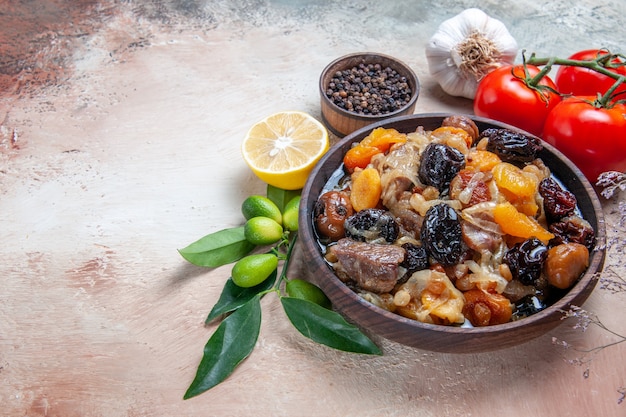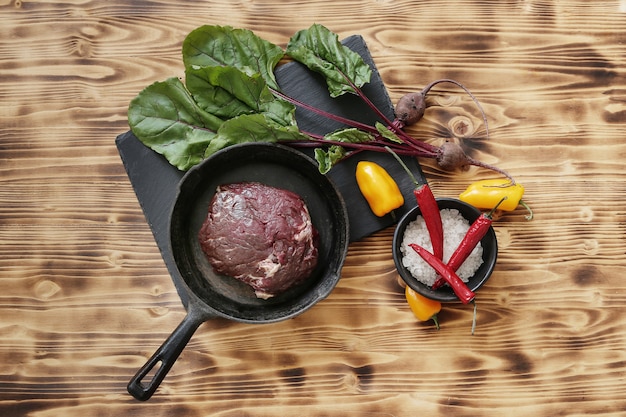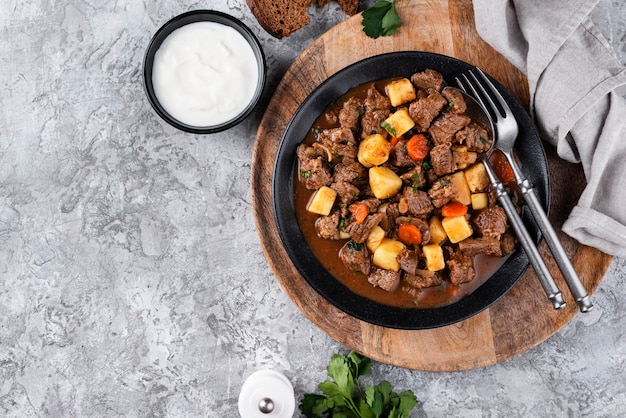(Part 1) The Foundation: Choosing the Right Beef

Finding the Perfect Beef:
So, chuck roast or brisket? It really comes down to personal preference. I'm a big fan of chuck roast. It's usually more affordable and works well in most recipes. Brisket tends to have a richer, more intense flavor. And don't forget about a good old-fashioned shin of beef. It's a classic choice for a traditional, hearty stew. But no matter which cut you choose, make sure it's well-marbled with fat – that fat will melt away during cooking, adding incredible flavor and moisture to your stew.
Trimming for Success:
Before you get started, take a moment to trim any excess fat from your beef. You don't want to remove all of it, as some fat is necessary for flavor and moisture, but too much can make your stew greasy. Just trim off the excess, leaving a thin layer of fat throughout the meat.
(Part 2) The Magic of Browning: Unlocking Flavor

Browning Your Beef:
Heat a large, heavy-bottomed pot or dutch oven over medium-high heat. Add a generous amount of olive oil or rapeseed oil, let it get nice and hot, and then carefully add your beef in batches – don't overcrowd the pan. Brown the beef on all sides, making sure to get a nice, crispy crust. You want to achieve that beautiful, golden-brown color. Once your beef is nicely browned, set it aside.
Don't Throw Away Those Flavor Bombs!
That pan, with all those tasty bits stuck to it? Don't you dare wash it! That's where the real magic happens. Deglaze the pan by adding a splash of liquid – red wine, broth, or even just water – and scrape up all those delicious caramelized bits. This is a flavour bomb waiting to be unleashed. Make sure to stir this into your stew later.
(Part 3) The Veggie Symphony: Adding Texture and Taste

My Go-To Stew Vegetables:
- Onions – a must-have for their sweetness and ability to balance other flavors.
- Carrots – adding a touch of sweetness and a satisfying crunch.
- Celery – bringing in a hint of earthy bitterness that adds complexity.
- Mushrooms – adding depth of flavor and a meaty texture that complements the beef beautifully.
- Potatoes – for that classic stew comfort factor. I like to use starchy potatoes like maris piper or king edward.
- Peas – a burst of color and freshness, adding a touch of sweetness and a nice textural contrast.
- Other Options – Feel free to experiment! Try adding root vegetables like parsnips, turnips, or sweet potatoes. Or add some hearty greens like kale or collard greens.
Cutting for Even Cooking:
Chop your veggies into nice, even pieces. It's not about being a Michelin-star chef, it's about ensuring everything cooks evenly. You don't want some veggies mushy while others are still crunchy.
(Part 4) The Broth or Stock: The Flavor Foundation
Now we're getting to the heart of the stew – the broth or stock. This is what brings everything together and creates that rich, satisfying sauce. I firmly believe that a good broth is the foundation of a fantastic stew.Homemade or Store-Bought?
You can make your own broth (which I highly recommend if you have time), or you can grab a good-quality store-bought broth. Just be sure to avoid those overly salty, artificial-tasting ones. If you're using a store-bought broth, try to find one with a good, full flavor. I like to use a beef broth or a vegetable broth, depending on the kind of stew I'm making.
Seasoning for Depth:
Now, a pinch of salt and pepper is always a good idea, but don't be afraid to experiment with other seasonings. A little thyme, rosemary, or bay leaf can add an extra layer of flavor.
(Part 5) The Art of Simmering: Letting Time Work its Magic
This is where the magic happens – time! Let your stew simmer gently on the stovetop for a good long time. I'm talking 2-3 hours, maybe even longer. This is what makes those tough cuts of meat incredibly tender and lets all those flavors meld together.Why Simmering Is Essential:
The slow, gentle simmering breaks down the tough connective tissues in the beef, making it incredibly tender. It also allows the flavors from the beef, vegetables, and broth to mingle and create a symphony of deliciousness. This is the secret to a truly melt-in-your-mouth stew.
Keeping an Eye on the Pot:
Don't go overboard. You don't want to overcook your stew. Keep an eye on it – the meat should be fork-tender and the vegetables should be cooked through but still have a bit of bite. If you're not sure, give it a taste test!
(Part 6) Adding Thickness: Achieving the Perfect Consistency
You might notice that your stew is a bit thin. No worries, we can fix that. I like to add a little thickening to my stew, just to give it a bit more body and a richer texture.My Favorite Thickening Agents:
- Cornstarch – a classic and reliable choice, creating a smooth, silky texture.
- Flour – another classic, giving you a bit more of a rustic texture. Be careful not to add too much flour, as it can make the stew cloudy.
- Tomato paste – adding a richer, deeper flavor and some natural thickening. Just a tablespoon or two will do the trick.
The Slurry Trick:
Combine a tablespoon or two of your chosen thickening agent with a little cold water, making a smooth slurry. Slowly stir this slurry into your simmering stew. Let it cook for a few minutes, until the stew thickens to your liking. Don't be afraid to add a bit more if you need it.
(Part 7) Serving Up a Feast: The Grand Finale
The moment of truth has arrived! Your beef stew is ready to be devoured.Serve it Up Hot:
Ladle a generous portion of your stew into a bowl. Garnish it with some fresh herbs, like parsley or chives. And don't forget a dollop of sour cream or crème fra??che on top – it adds a touch of tanginess and richness.
What to Serve With It:
Beef stew is so versatile! It goes great with mashed potatoes, fluffy rice, crusty bread, or even a side of green beans. Personally, I love to serve it with a big, crusty loaf of bread for dipping.
(Part 8) Leftovers: A Delicious Second Helping
If you're lucky enough to have leftovers (which, let's be honest, is highly likely!), you're in for a treat. Beef stew is even better the next day. The flavours have had a chance to meld even more, and the meat is even more tender.Storing Leftovers:
Store your leftover stew in an airtight container in the fridge. It should keep for 3-4 days.
Reheating Tips:
When you're ready to reheat, you can do it in a saucepan on the stovetop over low heat, or you can heat it in the microwave. I prefer to reheat it on the stovetop, because it helps to keep the stew nice and moist.
(Part 9) Recipe Time: Get Cooking!
Now, I know you're probably itching to try out a beef stew recipe. I've got a couple of favourites to get you going:1. Classic Beef Stew with Vegetables:
This is a tried-and-true recipe that's perfect for a comforting weeknight meal. It's simple to make, but the flavours are amazing.
Ingredients:
- 1.5 kg beef chuck roast, cut into 2.5 cm cubes
- 1 tbsp olive oil
- 1 large onion, chopped
- 2 carrots, chopped
- 2 celery stalks, chopped
- 2 cloves garlic, minced
- 1 tbsp all-purpose flour
- 1 tsp dried thyme
- 1 tsp dried rosemary
- 1 bay leaf
- 600 ml beef broth
- 2 potatoes, peeled and cubed
- 1 cup frozen peas
- Salt and pepper to taste
Instructions:
- In a large, heavy-bottomed pot or Dutch oven, heat the olive oil over medium-high heat. Brown the beef in batches, making sure to get a nice, crispy crust. Set the browned beef aside.
- Add the onion, carrots, and celery to the pot and cook, stirring occasionally, until softened, about 5 minutes.
- Add the garlic, flour, thyme, rosemary, and bay leaf to the pot and cook for 1 minute, stirring constantly.
- Pour the beef broth into the pot and bring to a boil. Reduce heat to low, add the browned beef, and cover the pot. Simmer for 2 hours, or until the beef is very tender.
- Add the potatoes to the pot and continue simmering for 30 minutes, or until the potatoes are cooked through.
- Stir in the peas and cook for 5 minutes, or until heated through.
- Season with salt and pepper to taste. Serve hot, garnished with fresh parsley, if desired.
2. Beef Stew with Red Wine and Mushrooms:
This is a bit fancier, but still relatively easy to make. The red wine adds a beautiful complexity to the flavours.
Ingredients:
- 1 kg beef chuck roast, cut into 2.5 cm cubes
- 2 tbsp olive oil
- 1 large onion, chopped
- 2 carrots, chopped
- 2 celery stalks, chopped
- 4 cloves garlic, minced
- 1 tbsp all-purpose flour
- 1 tsp dried thyme
- 1 tsp dried rosemary
- 1 bay leaf
- 250 ml dry red wine
- 500 ml beef broth
- 250 g mushrooms, sliced
- 2 potatoes, peeled and cubed
- 1 cup frozen peas
- Salt and pepper to taste
Instructions:
- In a large, heavy-bottomed pot or Dutch oven, heat the olive oil over medium-high heat. Brown the beef in batches, making sure to get a nice, crispy crust. Set the browned beef aside.
- Add the onion, carrots, and celery to the pot and cook, stirring occasionally, until softened, about 5 minutes.
- Add the garlic, flour, thyme, rosemary, and bay leaf to the pot and cook for 1 minute, stirring constantly.
- Pour the red wine into the pot and bring to a boil. Reduce heat to low and simmer for 5 minutes, or until the wine has reduced by half.
- Pour the beef broth into the pot and bring to a boil. Reduce heat to low, add the browned beef, and cover the pot. Simmer for 1.5 hours, or until the beef is very tender.
- Add the mushrooms, potatoes, and peas to the pot and continue simmering for 30 minutes, or until the vegetables are cooked through.
- Season with salt and pepper to taste. Serve hot, garnished with fresh parsley, if desired.
3. Hearty Beef Stew with Guinness:
This is a real crowd-pleaser. The Guinness adds a rich, malty depth of flavor to the stew.
Ingredients:
- 1.5 kg beef chuck roast, cut into 2.5 cm cubes
- 2 tbsp olive oil
- 1 large onion, chopped
- 2 carrots, chopped
- 2 celery stalks, chopped
- 4 cloves garlic, minced
- 1 tbsp all-purpose flour
- 1 tsp dried thyme
- 1 tsp dried rosemary
- 1 bay leaf
- 400 ml Guinness
- 400 ml beef broth
- 250 g mushrooms, sliced
- 2 potatoes, peeled and cubed
- 1 cup frozen peas
- Salt and pepper to taste
Instructions:
- In a large, heavy-bottomed pot or Dutch oven, heat the olive oil over medium-high heat. Brown the beef in batches, making sure to get a nice, crispy crust. Set the browned beef aside.
- Add the onion, carrots, and celery to the pot and cook, stirring occasionally, until softened, about 5 minutes.
- Add the garlic, flour, thyme, rosemary, and bay leaf to the pot and cook for 1 minute, stirring constantly.
- Pour the Guinness into the pot and bring to a boil. Reduce heat to low and simmer for 5 minutes, or until the Guinness has reduced by half.
- Pour the beef broth into the pot and bring to a boil. Reduce heat to low, add the browned beef, and cover the pot. Simmer for 2 hours, or until the beef is very tender.
- Add the mushrooms, potatoes, and peas to the pot and continue simmering for 30 minutes, or until the vegetables are cooked through.
- Season with salt and pepper to taste. Serve hot, garnished with fresh parsley, if desired.
(Part 10) FAQs: Your Beef Stew Questions Answered
Let's get to those burning questions you've probably got.1. Can I use a slow cooker for beef stew?
Absolutely! Slow cookers are fantastic for making beef stew. Just follow the same browning instructions, then transfer everything to the slow cooker and cook on low for 6-8 hours, or on high for 4-6 hours. The slow cooker does all the work for you, resulting in a super tender and flavorful stew.
2. What if my beef isn't tender enough?
No worries, this happens. If your beef isn't tender enough after simmering for the suggested time, just add a bit more liquid (broth or water) and keep simmering for another 30 minutes to an hour. You can also shred the beef with two forks to make it easier to eat.
3. How do I keep my stew from getting too thick?
If your stew gets too thick, just add a bit of water or broth. You can also adjust the thickening agent amount before adding it to the stew.
4. Can I make beef stew ahead of time?
Yes, absolutely! Beef stew is actually better the next day, as the flavours have had a chance to meld. Make it the day before and reheat it before serving. It's a real time-saver.
5. Can I freeze beef stew?
You bet! Beef stew freezes beautifully. Let it cool completely, then transfer it to an airtight freezer-safe container. It will keep for 2-3 months in the freezer. Thaw it in the refrigerator overnight before reheating.
6. What are some variations I can try?
The beauty of beef stew is its versatility! You can experiment with different flavors and ingredients. Try adding a touch of chili powder for a hint of spice, or add a dollop of Dijon mustard for a tangy twist. Feel free to get creative in the kitchen!
There you have it! Beef stew doesn't have to be a mystery. With a little guidance and some time in the kitchen, you can create a delicious, comforting meal that will have everyone begging for seconds. So, what are you waiting for? Grab your ingredients and get cooking!Everyone is watching

Corn on the Cob: The Ultimate Guide to Perfectly Cooked Ears
Healthy MealsAh, corn on the cob. Just the name evokes images of sunny days, barbecues, and that sweet, juicy flavour that ...

Perfect Pork Roast Oven Cooking Time: A Guide to Delicious Results
Healthy MealsThere's something truly satisfying about a perfectly roasted pork. The aroma alone is enough to make your mout...

Scallops: The Ultimate Guide to Perfect Cooking
Healthy MealsAh, scallops. Those delicate, sweet, and utterly delicious morsels of the sea. They hold a special place in my...

Ham Cooking Time: How Long to Bake, Smoke, or Boil a Delicious Ham
Healthy MealsAh, ham. It's a classic, isn't it? A real crowd-pleaser, especially around holidays. And when done right, it'...

Spaghetti Squash: The Ultimate Guide to Cooking and Serving
Healthy MealsRemember that time you saw spaghetti squash at the supermarket, looking all bumpy and strange, and thought, "W...
